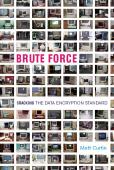Errata for Brute Force: Cracking the Data Encryption Standard
Software has bugs. Books have errata. This is the complete
list of known errors and other problems; these will be corrected
in subsequent printings. This list includes typographical
errors, technical editing errors (excessive generalization that
impacts the correctness or clarity of meaning), and copy editing
errors (such as an incomplete sentence). If you find a problem
that is not mentioned here, please add a note here or send me
email.
| Page | Comment |
|---|---|
| 4 | Enigma twice appears as “Engima.” |
| 12 | Lucifer was originally designed as a 128-bit cipher. Some have suggested that IBM actually submitted a 70-bit variant, rather than the 112-bit variant that I reported. I'm rechecking references and will update this page when I have found something authoritative and specific. |
| 14 | The difference between 256 and 2112 is not a factor of 56 but a factor of 256—a factor of roughly 72 quadrillion. Table 1 shows the difference correctly but the text underneath contains the error. |
| 35 | I mention two-key and three-key variants of Triple-DES, that they have effective key strengths of 112 and 168 bits, respectively. While that was the objective of these variants, the fact is that thanks to an attack known as meet-in-the-middle, the actual effective key strength is less, probably closer to something like 88-bit for two-key 3DES and somewhere between 113-bit and 120-bit for three-key 3DES. This was probably worthy of a note in the main text but at the time I left it out to avoid bogging down nontechnical readers. |
| 44 | Peter Trei reminded me that in fact the DESKR client for Pentium processors was written in hand-optimized assembler, and was for a while among the fastest of the DES-cracking clients. I neglected to mention this in the text, giving the impression that all DESKR implementations were entirely C-based. |
| 46 | ¶6 should begin as, “Now it was obvious that”… |
| 46 | ¶8 should begin as, “No one seriously believed that attacking”… |
| 51 | ¶2 “use” should appear as “used” in the parenthetical remark. |
| 125 | ¶4, line 7, “to get ” is inadvertently doubled. |
| 134 | Line 2, “ever few hours” should read “every few hours”. |
| 143 | ¶2, line 10 should start, “find its name”… |
| 154 | ¶4 should conclude, …“with the Macintosh clients being downloaded several hundred times.” |
| 155 | The first line should read, “After the list began receiving”… |
| 155 | An unmatched closing parenthesis appears inadvertently in the Verser quote. |
| 164 | ¶1, line 9, “present” should be “presented.” |
| 167 | Line 3 should be “a 56-bit”… |
| 169 | Line 2 should read, …“Bovine group”… |
| 176 | ¶7, line 1 should start, “In reality, clients would not be started so evenly”… |
| 180 | ¶1, line 9 should be, …“the longer that an algorithm is studied”… |
| 180 | ¶3, line 3, “to decrypting” should be “of decrypting.” |
| 190 | ¶2, line 8, “had about a week” should read “had been about a week”… |
| 192 | ¶1, first sentence should read: “What the release of all of these bitslice clients meant can be understood by analogy.” |
| 200 | ¶4. The final sentence should read, “Seven is a Mersenne prime because not only is it prime, but it is one less than the third power of 2, i.e., 23-1=7.” |
| 256 | First line should read, …“recovery systems, allow the federal government to access the keys needed”… |

